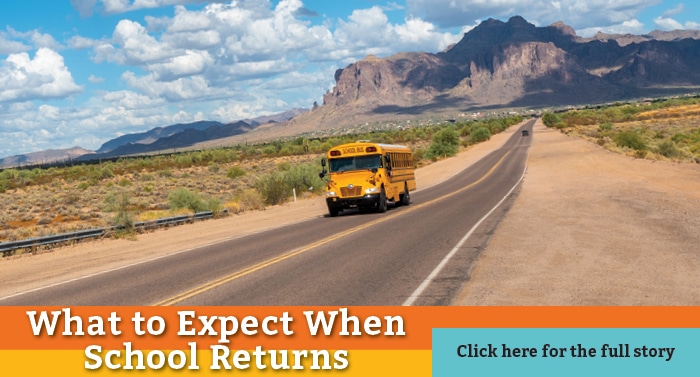By Christine Thompson
Schools are reopening soon. Is your family ready? The 2020-21 school year won’t look like any other that came before it. But exactly what it will look like remains to be seen. Schools and districts are busy preparing for the new year and many are releasing their plans this month.
The COVID-19 pandemic has created myriad uncertainties for educators, including what budgets will look like, how many students will return to the classroom and whether the virus will force another closure. Even with so much up in the air, districts are doing their best to create structure for students and families. Here’s what a few have planned:
Tucson Unified School District has surveyed both parents and staff to get a better idea of how people view returning to school. Their tentative plan calls for masks when students (grades 6-12) aren’t socially distant and the option for younger students (grades K-5) to wear a mask, as well. For those who aren’t able to or aren’t comfortable returning to school, online options will be made available. Campus access points will be limited, and lunches will be pre-packaged in grab-and-go containers.
Kyrene School District is offering parents three options, including returning to the classroom fulltime, becoming part of the Kyrene Digital Academy to learn remotely and a hybrid option that allows flexibility between in-classroom and digital learning. For those students who do return to physical schools, masks will be required. Lunches will be eaten in class and athletics will function on a modified schedule.
The Mesa Public Schools draft plan is the result of 170 people working thousands of hours and was informed by 27,000 survey responses from parents, students and employees. They are also offering in-person, remote and a blended model for parents to choose from. The district is providing laptops to all students, as a result of bond funds and a $6.5 million donation from the City of Mesa CARES program.
Knowing that some parents are uncomfortable having their child back in the school setting, many districts are offering distance learning options. Parents aren’t the only ones with concerns. While four out of five teachers plan to return to the classroom, according to a May survey by Expect More Arizona, more than half are very concerned about their and their students’ health. Of the 10,000 educators who responded to the survey, 18 percent remain unsure whether they will continue teaching.
Health and safety is the top concern, with student mental health and helping students catch up rounding out the top three. The majority of teachers favor rules requiring teachers and students to stay home if they are sick, in addition to strict sanitation procedures and access to cleaning products in the classroom. To help limit the potential spread of coronavirus, many schools are opting to restrict campus access for visitors and volunteers.
When schools closed unexpectedly in the spring, teachers quickly pivoted to distance teaching techniques. But most felt unprepared for the change. If distance learning continues, many have indicated interest in professional development to help keep students engaged when they’re not physically together. Three out of four also feel strongly that this fall should include assessments to gauge where students stand academically and what help they’ll need to move forward.
What can parents do to help ensure that the upcoming school year is the best it can be? Here are five ideas:
- Become familiar with your school/district’s plan for the coming year. If it’s not out yet, it will be soon. Reach out if you have questions and respond to surveys that will give you a chance to weigh in.
- Talk with your kids about what to expect when school resumes. Ask them how they are feeling and maintain an open line of communication.
- Continue the learning process. Encourage your children to read at least 30 minutes per day. If they don’t naturally love reading, find books on things they’re interested in – bugs, dinosaurs, or even books about video games. Seek out opportunities to practice math. Whether it’s fractions in the kitchen or online learning programs, keeping those muscles moving will help youth re-enter school.
- A few weeks before school starts, get back into a routine. Start earlier bedtimes and wakeups, so that the first week of school isn’t a shock to everyone’s system. If your school will require masks, consider practicing at home to help children acclimate. Regular reminders about handwashing and physical distancing will also help.
- Continue to be patient with educators. This isn’t something anyone has trained for and they’re doing their best for your kids.
Christine Thompson is president & CEO of Expect More Arizona, a nonprofit, nonpartisan organization bringing communities together to create positive change in education at all levels.

